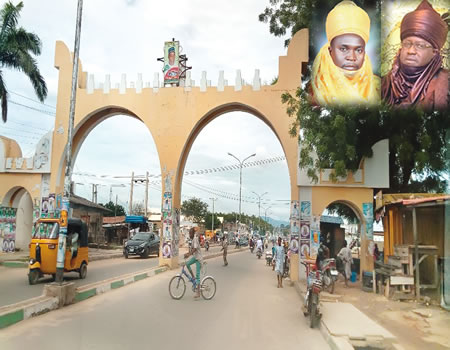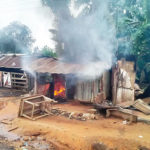Gates, constructed and adorned in traditional ways are common as entrance and exit points in major cities in the northern part of the country such as Kano, Zaria, Bauchi and others. Popularly called ‘Kofar,’ the gates have historical antecedents that are related to the emergence and existence of each of the cities. So it is in Bauchi, the capital city of Bauchi State.
Residents of Bauchi are, therefore, very familiar with the existence of gates across the city, such as Kofar Wunti, Kofar Jahun and even Kofar Gombe (Wambai). One thing though is the fact that only a very few of the residents know that these gates ‹Kofofi› used to be very small doors through which only persons approved by the Emir were permitted to enter the ancient city of Bauchi in those days.
Story behind the gates
In order to know more about the origin, importance and need for these gates, Arewa Live embarked on an historical investigation into the nine gates built round about the ancient city by the Bauchi Emirate.
The investigations unraveled the history behind these doors which were built by the founder of Bauchi, Mallam Yakubu in the 17th Century after the Jihad launched by Sheikh Othman Dan Fodio of Sokoto.
The nine gates are Kofar lnkil, Kofar Dumi, Kofar Wase, Kofar Jahun, Kofar Nassarawo, Kofar Wunti, Kofar Ran, Kofar Tirwun and Kofar Wambai.
According to the Wakilin Tahiri (Chief Historian of Bauchi Emirate), Alhaji Ado Dan Rimi, Bauchi was established as a result of the Sokoto Jihad of 1804 by Mallam Yakubu, who was the first Emir and flag bearer of Sheik Usman Dan Fodio which gives him the title of Sarkin Yakin Sarkin Musulmi a title that every Emir of Bauchi Emirate bears even till today.
Yakubun Bauchi was able to cover and protect most of the southern parts of the caliphate during the Jihad and had wide land coverage unlike most Emirs who concentrated only in their emirates.
Dan Rimi further explained that in 1807, Yakubun Bauchi, after capturing most of the areas during the Jihad, was invited to Sokoto to meet with Othman Dan Fodio to seek advice on the location he would start his own town because according to him Bauchi was regarded as a land of unity in diversity because of its combination of so many ethnic groups all living in the same location. The name Bauchi was coined from Baushe owing to the inability of the different ethnic groups to understand the other person›s language.
On Yakubu›s arrival in Sokoto, Othman Dan Fodio asked him where he was interested in starting his town and he was said to have suggested Wase, Babah or Zaranda but the Sultan told him that if he settled in any of these areas, his people would be rich without the Islamic faith but Islam would neither be cherished nor flourish as intended.
Mallam Yakubu then suggested another location called Inkil, but again, the Sultan told him that if his kingdom was established at Inkil, his followers would become singers instead of promoters of Islam. It was at that point, that Yakubu sought for the advice of Usman Dan Fodio as to where to site his town.
Dan Fodio then advised Yakubu to consider incorporating a part of the Warinje Hills area into his town but warned that the place was full of snakes. The Sultan, however, assured that he would pray to Allah for protection for Yakubu and his people.
Dan Rimi further said that: «He (Dan Fodio) assured Yakubu that if he built his town around the Warinje hills, nobody would be able to defeat him in war in that area, and Islam would flourish forever. Though he and his subjects would not be rich, but (they) will not be poor either, but Islam would grow and be sustained and they would live happily.
«On his return, Yakubu first went to Inkil, located a hill there in a virgin land with some rocks and started building his town where he first built a mosque, then a prison yard and the kingmakers’ house before building the town made up of the present day Bauchi.
According to Dan Rimi, between 1807 and 1812, Mallam Yakubu built the wall of the city of Bauchi, first with four gates namely – Kofar Inkil (or Idi), Kofar Tirwun, Kofar Wase and Kofar Wunti which were later increased to nine during the expansion of the city adding that few years after Bauchi was founded, it developed into a cosmopolitan city with different ethnic groups such as Jarawa, Nupe, Hausa, Gerawa, Arabs and so on.
Closer look at the gates
History has it that in order to meet the demand for space, Yakubu expanded Bauchi by building five more gates namely – Kofar Jahun, Kofar Ran, Kofar Nassarawo, Kofar Wambai and Kofar Dumi were added.
The Emir later built a wall surrounding the city while movement in and out of Bauchi was only possible through any of the nine doors thereby restricting movement. Dan Rimi explained that back then, the gates were usually closed by a metal door with heavily armed local security men on guard.
Remnants of two of the metal doors which were used to lock the gates in those days were shown to Arewa Live with the explanation that some of the metal doors can now be found in the National Museum in Lagos and Jos.
Two rooms were attached to each of the nine gates – one for Ajiya tax or revenue collector and the other room was for guests who arrived late and usually slept there for protection before being allowed in to the city in the morning.
“The door (gate) was always closed with two male keepers manning them. Anytime a visitor, guest or stranger wants to enter the city, the keepers asked him his mission and then informed his superior who in turn informed the emir,” he said.
Also called Kofar Eid, the Kofar Inkil gate was built by Yakubu to meet the demand of the people of Inkil, the first capital city of the emir. Before the gate was built, there were two Eid prayer grounds – one at Inkil and the other at Ran but both were later merged to form the popular Eid prayer ground behind the palace.
Kofar Dumi
This gate or door in local parlance was built to meet the demands of the people of Dumi. One of Yakubu’s disciples named Abdul Dumi who later became his Wambai, (adviser), was from Dumi. He escorted the first emir to identify the Bauchi area where the town would be located. The emir was said to have opened the gate as a mark or respect for Abdul Dumi who was sent to Wase for the Jihad. The gate was used by Abdul Dumi to come into Bauchi every Friday to discuss state matters with the emir after the Jummat prayer.
Kofar Jahun
This door or gate was built for the Fulanis of Jahun who resided outside the town since the Jihad. One of them, Farooq from Bayak was appointed as Galadima by Emir Yakubu and he usually used the gate any time he wants to see the emir. Dan Rimi disclosed that the British, led by Dr William Wallace arrived Bauchi through Jahun gate in 1902.
Kofar Nassarawo (now Nasarawa)
This was built for in and out movement of Mallam Nassarawo, a cleric who lived outside the town. The emir at the height of the Jihad usually spent three days in Nassarawo’s house praying for victory.
Kofar Wunti
This was built for the Sarkin Yaki or Commanding Officer of the Emir’s army named Mohammed Kusu. He was from the Wuntawa clan among the Fulani ethnic groups.
Kofar Ran
Ran was known for being a settlement which produced Islamic scholars from Bauchi. The gate was built to integrate them into the town.
Kofar Tirwun
This is the original town Emir Yakubu who was said to have originated from Tirwun. So he built the gate as a mark of respect to the people of Tirwun.
Kofar Wambai
After the expansion, Emir Yakubu relocated the Wambai (Adviser) to a land elsewhere where he build a house for him and built the Wambai gate as his entrance in and out of the palace.
It was further revealed that the nine gates were fixed to the mud wall built round the city, three metres both inside and outside. However, the gates have been redesigned to meet the demands of modern age.
“In those days camels and asses used to pass through, but now the gates have been redesigned to accommodate vehicular movements, especially big ones like trailers and tankers,» Dan Rimi explained further.
However, while the other walls had been redesigned, the same cannot be said of what used to be the wall built by the first emir, Yakubu Bauchi. With rapid urbanisation, what used to be the wall have been overtaken by residential houses especially around the Jahun, Nassarawo, and Wase gates, with the remains of the red mud wall still standing, a reminder of life after the Jihad when movements were restricted.
Bauchi, whose current emir, Dr Rilwanu Suleiman Adamu is the 11th ruler, has expanded since the time of Yakubu Bauchi to what it is today. The emir continues to exert influence within and outside the emirate but with the coming of colonialism and independence, the emir’s power has since reduced to cover only his domains. The practice of restrictions of movements in and out of the gates is also no longer practicable.
The gates, once so majestic and powerful as symbols of the authority of the emirate are now more or less mere relics still standing to beautify the city and a reminder of the rich cultural heritage of the ancient city.







